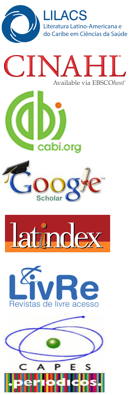Megakaryoblastic Acute Myeloid Leukemia Associated with a Testicular Tumour in a Young Adult: a Case Report
DOI:
https://doi.org/10.17921/2447-8938.2024v26n1p57-59Resumo
Abstract
Acute megakaryoblastic leukemia (M7 AML) is a rare subtype of acute myeloid leukemia in adults, the incidence of which is higher in children aged 1 to 3 years, especially in patients with Down Syndrome; and in the age group between 60 and 70 years old, with an adverse prognosis. We report the case of a 28-year-old male patient, with a history of non-seminoma germ cell tumour of the testis, diagnosed with M7 AML. Nine months after performing an orchiectomy to remove the testicular tumour, the patient developed dyspnea, dry cough and asthenia, associated with the presence of erythematous-purple lesions on the skin, ascites and pleural effusion. The myelogram demonstrated medullary hypocellularity, with the presence of 53% of blastic, pleomorphic and bulky cells, with positivity for the markers CD34, CD31 and CD117 in immature cells in immunohistochemistry. Despite undergoing cycles of chemotherapy with cisplatin and a BEP regimen (Bleomycin, Etoposide and Cisplatin), the patient presented with chest tomography with the presence of pulmonary nodules and magnetic resonance imaging of the skull and neuraxial with infiltration of the bone marrow in the spine and cranial vault, resulting in with neurological impairment and died. In view of the case presented, we observed agreement with previous reports of the adverse prognosis of M7 AML in young adults and we questioned its relationship with germ cell tumour.
Keywords: Leukemia. Hematology. Medical Oncology. Acute Megacarioblastic Leukemia.
Resumo
A leucemia megacarioblástica aguda (LMA M7) é um subtipo raro em adultos de leucemia mielóide aguda, cuja incidência é maior em crianças de 1 a 3 anos, especialmente em pacientes portadores de Síndrome de Down; e na faixa etária entre 60 e 70 anos, com um prognóstico adverso. Relatamos o caso de um paciente, do sexo masculino, 28 anos, com histórico de tumor germinativo não seminoma de testículo, diagnosticado com LMA M7. Nove meses após a realização de uma orquiectomia para a retirada do tumor testicular, o paciente apresentou quadro de dispneia, tosse seca e astenia, associado a presença de lesões eritemato-arroxeadas na pele, ascite e derrame pleural. O mielograma demonstrou hipocelularidade medular, com presença de 53% de células blásticas, pleomórficas e volumosas, com a positividade para os marcadores CD34, CD31 e CD117 em células imaturas na imunohistoquímica. Apesar da realização de ciclos de quimioterapia com cisplatina e esquema BEP (Bleomicina, Etoposídeo e Cisplatina), o paciente apresentou Tomografia de tórax com presença de nódulos pulmonares e ressonância magnética de crânio e neuroeixo com infiltração da medula óssea em coluna vertebral e calota craniana, intercorrendo com comprometimento neurológico e foi a óbito. Diante do caso apresentado observamos a concordância com relatos prévios do prognóstico adverso da LMA M7 em jovens adultos e indagamos a sua relação com o tumor de células germinativas.
Palavras-chave: Leucemia. Hematologia. Oncologia. Leucemia Megacarioblástica Aguda.
Downloads
Referências
Shallis RM, Wang R, Davidoff A, Ma X, Zeidan AM. Epidemiology of acute myeloid leukemia: Recent progress and enduring challenges. Blood Rev. 2019;36:70-87. doi: 10.1016/j.blre.2019.04.005.
Siegel RL, Miller KD, Wagle NS, Jemal A. Cancer statistics, 2023. CA Cancer J Clin. 2023;73(1):17-48. doi: 10.3322/caac.21763.
Salvaro M, Frassetto M, Just M, Furtado J, Macarini V, Schuck F, et al. Leucemia Mieloide Aguda: Perfil Clínico-Epidemiológico no Brasil entre 2009 e 2019. Hematol Transfus Cell Ther. 2021; 43(S1): S505-506. doi.org/10.1016/j.htct.2021.10.871.
Cirolini Oliveira, C., Quintana Castro, C., & Hörner, R. Perfil epidemiológico de pacientes com leucemia mieloide aguda: Uma revisão integrativa. Saúde (Santa Maria). 2021;47(1). https://doi.org/10.5902/2236583464519
Catovsky D, Matutes E, Buccheri V, Shetty V, Hanslip J, Yoshida N, Morilla R. A classification of acute leukaemia for the 1990s. Ann Hematol. 1991;62(1):16-21. doi: 10.1007/BF01714978.
Tallman MS, Neuberg D, Bennett JM, Francois CJ, Paietta E, Wiernik PH, Dewald G, Cassileth PA, Oken MM, Rowe JM. Acute megakaryocytic leukemia: the Eastern Cooperative Oncology Group experience. Blood. 2000;96(7):2405-11. doi.org/10.1182/blood.V96.7.2405.
Hahn AW, Li B, Prouet P, Giri S, Pathak R, Martin MG. Acute megakaryocytic leukemia: What have we learned. Blood Rev. 2016;30(1):49-53. doi: 10.1016/j.blre.2015.07.005. Epub 2015 Jul 18.
Brouwer N, Matarraz S, Nierkens S, Hofmans M, Nováková M, da Costa ES, Fernandez P, Bras AE, de Mello FV, Mejstrikova E, et al. Immunophenotypic Analysis of Acute Megakaryoblastic Leukemia: A EuroFlow Study. Cancers. 2022;14(6):1583. https://doi.org/10.3390/cancers14061583.
Wang LX, Liao WJ, Jiang YH, Chen C, Lu WS, Yin F, Ning HY. Gene mutation landscape of a rare patient with acute megakaryoblastic leukemia after treatment of intracranial germ cell tumor. Front Oncol. 2023;13:1093434. doi: 10.3389/fonc.2023.1093434.
Downloads
Publicado
Como Citar
Edição
Seção
Licença
Os autores devem ceder expressamente os direitos autorais à Kroton Educacional, sendo que a cessão passa a valer a partir da submissão do artigo, ou trabalho em forma similar, ao sistema eletrônico de publicações institucionais. A revista se reserva o direito de efetuar, nos originais, alterações de ordem normativa, ortográfica e gramatical, com vistas a manter o padrão culto da língua, respeitando, porém, o estilo dos autores. As provas finais serão enviadas aos autores. Os trabalhos publicados passam a ser propriedade da Kroton Educacional, ficando sua reimpressão total ou parcial, sujeita à autorização expressa da direção da Kroton Educacional. O conteúdo relatado e as opiniões emitidas pelos autores dos artigos são de sua exclusiva responsabilidade.


